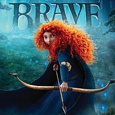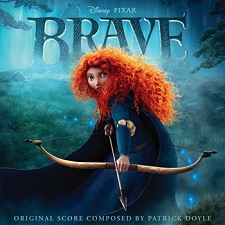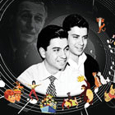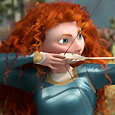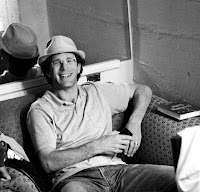 Have Pixar found their own “staff-songwriter” (the position held at Walt Disney Productions by the Sherman brothers, the only full-time in-house songwriters Walt Disney had hired)? Alex Mandel’s position at Pixar is definitely different but you can’t help thinking about that when considering his latest adventure.
Have Pixar found their own “staff-songwriter” (the position held at Walt Disney Productions by the Sherman brothers, the only full-time in-house songwriters Walt Disney had hired)? Alex Mandel’s position at Pixar is definitely different but you can’t help thinking about that when considering his latest adventure.
Alex Mandel has been a Pixar manager on such films as Up, Toy Story 3, and Cars 2 and a filmmaker well versed in the collaborative nature of film production, but at the same time he’s an acclaimed songwriter, multi-instrumentalist, producer, and composer for film, TV and radio who came to write two songs for the Lamp’s latest hit movie, Brave.
A genuine Pixarian, he also composed the score for the Pixar short film Your Friend the Rat, directed by Academy Award Nominee Jim Capobianco (Best Original Screenplay, Ratatouille), which won the Annie Award in 2007 for Best Animated Short Film.
He has released four critically-acclaimed albums of his songs, one with The Echo Falls and three with The Fingers. These songs have been featured in many TV shows, including Everwood, Notes From the Underbelly, and Teen Mom 2.
Alex Mandel’s two “Brave new songs”, performed by acclaimed Scottish Gaelic singer Julie Fowlis, are among the film’s musical highlights. Touch the Sky accompanies Merida’s liberating and exhilarating ride through the forest when she is able to escape the confines of castle life whereas Into the Open Air is heard later in the film during a special moment between mother and daughter.
The multi-faceted artist shares with us his unlikely adventure, from Emeryville to Ancient Scotland.

Animated Views: What led you to working at Pixar?
Alex Mandel: Nine years ago, I was giving guitar lessons to an animator at Pixar and he said: “you know, you should really come by and visit”. And I did. I had just seen Finding Nemo which of course I loved. So, I went there and I thought I’d just love to be a part of this. I wanted to be at Pixar. So, I actually applied for a job as a coordinator, which is someone who takes notes and sets up meetings to help keep movies going. I did that for a number of years and then I became a manager. That’s my official role at Pixar: I’m a manager in film production.
AV: In parallel to that position at Pixar, you’ve kept playing music. I must say I’m a great fan of your band, The Echo Falls and its unique blending of indie folk-rock, film scores, concert music, and improv/experimental music.
AM: I have been in bands since I was eleven years old, playing all kinds of music. But around the time that I came to Pixar, I basically said: “ok, well, I’m not going to make a living doing music.” Pretty soon after I came to Pixar, people saw me playing the guitar and heard my music and they started asking me to do stuff. So, I continued to do more and more music at Pixar up to writing two songs for Brave. It’s not my official job, but people heard The Echo Falls and they asked me to do music for Pixar.
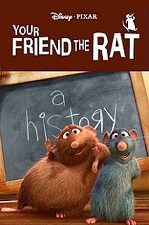
AV: You’re not only a songwriter, but also a score composer, like for the Pixar short Your Friend the Rat.
AM: It’s something that I noticed when I would watch movies – it’s certain scores which stick out for me. And one of the first scores that stuck out for me was Danny Elfman’s music. I remember thinking: I’m noticing the music in a good way. When I thought that Danny Elfman had been in a band, Oingo Boingo, I started to notice that certain types of musicians who had done scores I like like Jon Brion have been in bands, then they made that transition to score. And something that I like about a lot of these guys is that it’s very thematic and melodic. There’s a thematic element to the score.
And I think the next thing that happened was I was working on a short film called One Man Band and I met Michael Giacchino. I actually got to go to his house. This was about eight years ago. I was a coordinator just taking notes in the meetings. I met Michael and I saw how he was talking to the directors. Up until that point, I was a songwriter and have been in bands, but when I saw Michael, I thought I could do this. He’s so smart and he was a good listener. He wasn’t really talking about music. He was talking about filmmaking. And that was really the moment when I thought “that’s something I’d like to do”. Michael has been a great help and the first score I did was Mr. Incredible and Pals which was on the Incredibles DVD. It was a Clutch Cargo parody, you know, that television program of the 1960’s that had drawings. And to save money, they filmed human mouths talking and composed them on the drawings. It was a very silly short film, but it was my first score!
That’s really the first time I thought “I could do this”, and Brad Bird heard it and he liked it. So, he became a supporter and once I did that, that led me to do Your Friend the Rat, which was the first time I got to work with a small chamber orchestra. That’s how it happened. For me, as soon as I’ve been at Pixar, it’s been basically like a master’s course in filmmaking. I just listened to these directors talking filmmaking, about music, about the work. And I just tried to pay attention the best I could so that, when I started writing scores, I could kind of anticipate what they were looking for.

AV: Can you tell me about your meeting with Mark Andrews and your scoring of his short film, Violet?
AM: I got to know Mark because he was actually one of the directors on One Man Band and we became friendly. You know, at Pixar, in the animation area, there is a band set up. There is drums, there is guitars, there’s a piano. A lot of times, especially when I first got there, every Friday night, there would be a kind of party and we played music together. Mark and I would play music. He’s a drummer. A very good drummer. A very powerful drummer. He hits really hard! He’s a very powerful personality and he hits the drums like hell! So we hit it off and played music together.
Then, Violet was the first film that Pixar University put together. Pixar University is something that was set up at Pixar to allow Pixar employees to get experience doing live action films. Violet was a film that was written by Craig Good, another longtime Pixar guy. He wrote the screenplay and Mark was elected to director. It’s really a student film. It’s a training ground to get experience. It’s a story about an older woman who lives by herself and she gets set up on a date with a guy. And, as the movie progresses, you realize she’s a murderer and that she had done it before and that she’ll kill again! Fortunately, Mark asked me to score it.
The nature of music there was – Mark and I didn’t want to do music that would give it away. So I wrote a piece of music about someone being good, influenced by a French composer, Eric Satie. It was very simple, modal and a little bit spooky, but you can’t tell if it’s scary or sad. That was the intention. So, when you hear it at the beginning, you think that’s kind of a sad story about this older woman, but at the end when you realize she’s a murderer, you hear the same theme in a different light. It’s now ambiguous and you feel what the music is about.

AV: How were you introduced to the universe of Brave, in order to compose the song Into the Open Air, which is the first song you wrote for the movie?
AM: I had lunch one day with Brenda Chapman. We were talking about what inspired her to make a film. She came up with a story and she was just talking about her relationship with her daughter. You know, I’m a father of two children, so I could relate to the struggles that parents and children have. It’s something that just stuck with me. It’s really the heart of the story of Brave. It’s not really specifically about a relationship between a mother and her daughter, but between parents and children. It’s one of the most important relationships you have in your life, and it’s also the hardest at time. And then, later, about a year ago, when Mark yelled my name across at Pixar saying “I have an opportunity for you!”, I was already familiar with this kind of heart of the story. He talked to me about a scene. Without giving to much away, it’s an emotional scene between Merida and her mother.
The challenge they were having was: they’re having a good time together in the scene. They’re having fun and it’s one of the first times you really feel them connected. But at the same time, nothing’s resolved yet. So, the challenge was to have a song that could explain some of the subtext for the scene, that expresses the emotion, but that’s not too celebratory. And some of the songs they had listened to were too celebratory or too sad. They wanted something bitter-sweet. It’s really this sense of possibility: could these walls that we built crumble down? “Can we carry this love that we share into the open air?” Step into the open air: that characterizes Merida, that’s what she’s about. She wants the outside, the nature. She wants to be free; she doesn’t want the constraint of the castle.
We talked about that both with Mark and Steve Purcell, who’s the co-director and one of the main writers of the film. You know, there’s a lot of conversations that you have during the process. Steve and I had lunch together and I showed him some of my early ideas. There was one lunch in particular where I had written about 30 verses!… and Steve helped me concentrate on the verses that really worked and he kind of suggested some ideas. I had this line that said: “I tried to speak to you every day but each word we spoke the wind blew away” – that phrase came out from that conversation with Steve which I remember very specifically. We also talked about this kind of more archaic style of writing, years ago, when emotions weren’t spoken up the same way. You wouldn’t say “I love you so much” or “my heart is bursting.” Then you might say “This love it is a distant star guiding us home wherever we are.” It’s a little more metaphoric, a little less direct. So, this is some of the things we talked about when I was writing the song.

AV: What relationship do you see between music and lyrics?
AM: I do them together. The way I write songs, words and music are very connected. So, I actually wrote the lyrics and the music together, at the same time. For Into the Open Air, I wrote too many verses on purpose. Because I know enough about the filmmaking process to know that there’s always someone to say “I don’t like these words” and it’s good to have extra words. Also, if the scene changes, you can move a verse around and comment what’s happening now in the scene.
AV: Where did you draw your inspiration for the song?
AM: Well, I’m a big fan of English and Scottish-Irish folk-rock music. Both Mark and I are big Led Zeppelin fans. This record, Led Zeppelin III, kind of brought it together that kind of folk-rock, modal composition that I used on Brave. There’s a lot of these bands, Fairport Convention, Richard & Linda Thompson, Donovan, a lot of these singers-songwriters that created a kind of a folk-rock tradition.
But then, I also did some research and listened to some more traditional Scottish folk music. I have collected a bunch of recordings by Alan Lomax of Southern folk and blues and gospel music. It’s called Sounds of the South. He recorded that in America during the 1950s and 1960s at a time when people didn’t listen to records. They learned songs from going to church or from the guy nearby who’d do a song. And then I learned that Alan Lomax had gone to Scotland in the 1950s. He was under investigation by the House Un-American Activities Committee. As he was suspected of being a communist, so he left the country and he went to Scotland and England, and recorded there traditional, folk music. Listening to those recordings, those mainly a capella, vocal-only songs that were done in Scotland, and the structure of the melodies, I found some of the melodic ideas for my song.
I wanted to feel authentic, but a lot of the work you do in animation is caricature. And it’s not a bad thing as far as caricature is about identifying the heart of something and exaggerating it a bit having a new perspective on it. I didn’t want the song to be totally an authentic Scottish folk song. I wanted something that felt authentic, but also relatable to a contemporary audience. Just like Merida who is a girl from years ago and at the same time is like us. The daughter-and-mother relationship is really something that a contemporary audience can relate to, and I wanted the songs to have that, too.
AV: In a way, you came back to the roots of American folk music that come from the Old World to create a style half way between the New World and the Old World.
AM: Very well said! Yes. I realized that when I listened to Sounds of the South, and especially the bluegrass music. That music came from Scot-Irish immigrants who came to the Appalachian mountains. They heard the slave songs, the songs of the Black people who came from Africa, and they formed something new which is bluegrass, which is the basis to country music. And then, what I noticed when I was listening to these songs of Scottish and Irish folk music is how familiar they sounded, rhythmically and melodically. So, bluegrass and Scot-Irish folk music have a lot in common.

AV: So, you did a lot of intriguing research, but at the same time you put a lot of yourself into that song.
AM: I’m not Scottish. I’m a songwriter who wanted to write a song that felt coming from the heart and conveyed emotion. Remember: I didn’t think my song would be used. I think Katherine Sarafian, our producer, was very careful to say: “we just want to see if a song could work in the scene.” So, I thought to myself: “I want to make sure that I write songs that at the very least, I really like”. That way, if they don’t get chosen, at least I could say: “well, you know, I think they were pretty darn good songs.” The worst that you can do when you are a musician is try to second-guess what people can like, and then you create something you think they might like and then they don’t choose it. That’s the worst because you create something you don’t love and they don’t love! Fortunately, in this case, not only was Into the Open Air used but what became Touch the Sky was also used.
Of course, I’m thrilled. I trust the process at Pixar. There’s a lot of creative people and the way it works is – the best idea wins. It’s not about who says it. It’s “what is the thing that’s gonna make the film work?” And that’s, I think, why Pixar movies are so good. Fortunately for me, they felt like using my songs would be the best, so that’s a huge compliment! Whatever happens next is not as important as the fact that Mark Andrews, Steve Purcell and Andrew Stanton, you know, all these guys heard the song and said: “we think this is exactly the right song for the movie.” That was a huge honor for me.
AV: What about the creation of your second Brave song, Touch the Sky?
AM: That song was written a week before an internal screening. I went and I played Into the Open Air for Mark and Katherine, and for Nick Smith, our editor on the film. I actually had the song cut to the scene but first I played them the song. Mark said: “that’s good. I think there’s some changes we may need to make but it’s a good song.” And I said “well, let’s watch it with the scene.” Then, we watched it with the scene… and it really fit! It was very similar to what’s in the movie now, actually. They all realized it was actually working. It’s an emotional scene. And, when the scene stopped, Mark turned to me and said: “cut it in! It’s going to the screen!… Now, there’s another song I want you to write, too! It’s this opening scene where Merida rides through the forest, she’s climbing a waterfall… I’ll tell more about that later!” So, I just went write another song!
That one was more of a collaboration. I brought it in about three or four days later and Mark made comments. He wanted the introduction to be more energetic. He literally played it. You know, he’s a drummer, so he had this very percussive idea in his head, what it should be like. So, then I went and re-did the introduction which is what is in the movie now, this very syncopated, very driving line the rhythm of which is kind of a variation on what Mark said to me. It’s me playing guitar.
That song went through revisions actually and, at one point, some original lyrics which I liked – but you know, all these things are reviewed by John Lasseter, by Mark, by Steve Purcell and by Katherine – weren’t quite what they were looking for. So, Mark rewrote the three verses kind of using the rhythm and the language that I had in the original version. So, we came to a co-written song where I wrote the music and Mark and I co-wrote the lyrics.

AV: How did the recording with Julie Fowlis go?
AM: I actually met Julie Fowlis for the first time at the Premiere. It is pretty surreal to collaborate with someone never having met them. But it worked out really well. We were considering different singers to record the songs and I should say that, when I did demo versions of the songs, I had a friend of mine who sang it because I knew it had to be a female voice. Mark even said: “you could sing one of these”, but I answered: “I’m not gonna sing one of these. This is Merida. It’s got to be a female singer.” So, the folks at Disney, Tom McDougall and Chris Montan had made a list of potential singers, and on the top of the list was Julie Fowlis. She a wonderful, amazing singer! She sings almost exclusively in Scottish Gaelic. She does traditional Scottish folk music. She has this incredibly clear, precise quality to her voice which is really special.
On Touch the Sky I did a string part which I had on the demo which Mark liked, so I sent them that string part. And on Into the Open, I used a kind of strange tuning. It’s an usual tuning, an “open” tuning, which helps play the part, otherwise it’s complicated. So, I sent all that to Julie and to Jim Sutherland, who produced the songs overseas, through the Disney folks. They recorded everything in Scotland using these great traditional instruments. Then, they sent it back. The challenge then was: Mark had gone very familiar with the arrangement I had done with the demo. So, we tried to find a middle ground between these great authentic Scottish instruments and the demo. We wanted to find a kind of hybrid, so, I played the guitar on both tracks. Now, it sounds as we said earlier, as a middle ground between traditional Scottish folk music and American song.
AV: From guitar teacher to feature film songwriter, what an amazing journey you have had at Pixar!
AM: As I said, I was thrilled that Mark asked me to write the songs. I love Brave and I’m thrilled I have my songs in there. If my songs had not been used, I would have thought “Well, I contributed to the creative process and I have to trust the brain trust and the process.” But, fortunately, I got an email from Katherine, the producer, I think it was in late January, and she said: “let’s get together with Mark, Steve and me talk about the songs for the picture.” There was plural – songs! When I read that, I thought “okay – I think I’m in the right universe!” Getting that email from Katherine was the turning point after nine months when I realized my songs would actually be in the movie. I think I wrote then an email to Steve Purcell and Mark saying: “this is the best email I’ve ever received in my career!”
available to order now from Amazon.com

Our thanks to Alex Mandel, Chris Wiggum and Tiffany Woolf.


